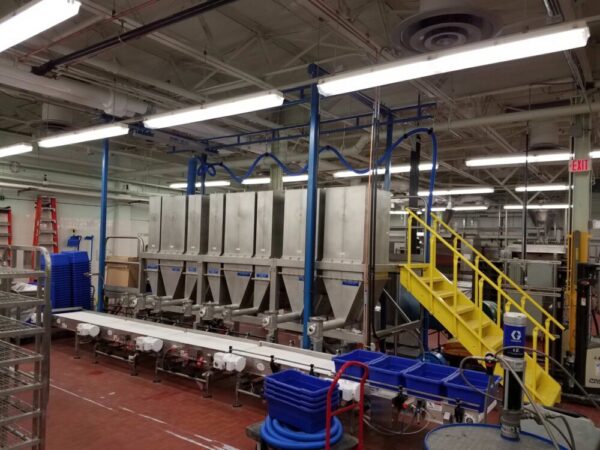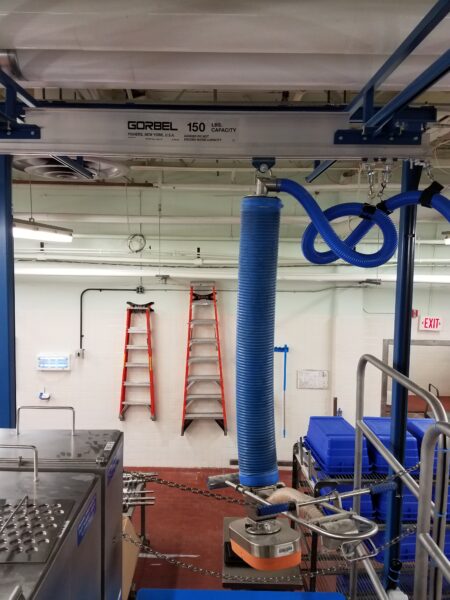Bread Batching

An automatic ingredient bread batching system can be used to produce a variety of breads. In this application example, an 8-bin minor ingredient system is used to batch the ingredients required to produce organic breads. The customer desired to create each bread batch in a tote. The system consists of 8 stainless steel storage bins and augers, an industrial TEFC electric motor for each feeder, a stainless steel frame supporting the bins, a 5-section conveyor system (in-feed conveyor, scale 1 conveyor, scale 2 conveyor, scale 3 conveyor, and exit conveyor), stairway, walkway, and pallet stand. A scissor lift and a pneumatic bag hoist are also included in this custom-engineered solution.
Sterling Systems & Controls also supplied all electrical controls and automation for this bread batching system. Therefore, the system included two (2) control panels: Motor Starter Panel and PLC/Operator Interface Panel. Both panels are rated NEMA 4X and are of stainless steel construction. All VFDs (variable frequency drives), contactors, and the PLC processor are Allen-Bradley. Four (4) weight instruments are installed and configured for Ethernet/IP communications on the PLC/Operator Interface Panel.
The controlling software for this bread batching system is Sterling Systems & Controls customized FactoryTalk View ME software running on a PanelView+ Touchscreen HMI in the PLC/Operator Interface Panel, where formulas and ingredients are created and scheduled to batch. Up to 25 formulas containing up to 75 ingredients each can be stored simultaneously in the PLC.
Batching System
In this case, the bread batching system consists of both automatic and semi-automatic batching processes. The automatic process dispenses ingredients from eight supply bins into containers without operator involvement. The containers are indexed under the discharge point of the feeding devices. The semi-automatic process prompts an operator to hand-add ingredients into a container on a platform scale. The automatic and semi-automatic batching processes run simultaneously for the same batch. Both processes are controlled from the PanelView+ HMI on the PLC/Operator Interface Panel.
How the Automatic Minor Ingredient Batching Process Works: The automatic bread batching system will dispense ingredients according to a predetermined formula into totes. Each tote is 13” x 22” x 8.5”. A supervisor will determine the number of totes that are required based on the batch formula. The operator manually places the totes onto the inlet of the in-feed conveyor (conveyor section 1 of 5). There is a “container-in-place” optical sensor on the In-feed conveyor. An alarm is initiated if a new tote is required, but none is sensed. When a tote is required at the Scale #1 position (on the conveyor section 2 of 5), the system automatically feeds the tote from the in-feed conveyor onto the Scale #1 conveyor. If a tote is required on the Scale #2 conveyor, and the tote has finished at the Scale #1 station, then the system indexes the tote onto the Scale #2 conveyor (conveyor section 3 of 5). If a tote is required at the Scale #3 conveyor (section 4 of 5), the system indexes the tote similarly. Once a tote has finished at the first three scale stations, it is indexed onto the Exit conveyor (section 5 of 5). Several Fixed Field Tote Sensors are located throughout the conveyor system to determine if the totes are in the correct position for loading, conveying, and indexing.
How the Semi-Automatic Batching Process Works: The semi-automatic bread batching process uses the same control panel and PanelView+ Touchscreen HMI as the automatic process. The semi-automatic system creates batches of hand-add ingredients that are placed with the automatic minor ingredient batch. The following procedure is used to operate the semi-automatic process in this application:
- The semi-automatic batching screen will prompt the operator to place a container on the semi-automatic platform scale for tarring. Once the container is detected on the scale, the system will turn on the lighted “Continue” pushbutton. The operator will press the lighted “Continue” pushbutton, the system acquires a tare weight.
- The system then prompts the operator to add the programmed amount of the first hand-add ingredient to the batch. The system will display the required weight and allow the operator to weigh the ingredients into the batch container.
- Once the system detects that the amount added to the batch is within the programmable over/under weighment tolerence, it illuminates the “Continue” lighted pushbutton.
- The operator presses the pushbutton and the system repeats steps 2-3 for each hand-add ingredient required in the formula.
- If an ingredient that has a “Bag Size” other than zero is encountered, as specified in the Ingredients screen, the system prompts the operator to pick the appropriate number of whole bags and then prompts the operator to weigh the remaining “odd” weight. For example, if an ingredient target weight is 122lbs and the ingredient bag size is 50lbs, the system will first ask the operator to pick and confirm they have two (2) full bags of the ingredient, and then will prompt the operator to weigh the remaining 22lbs into the container on the platform scale. Full bags are not weighed and are not placed on the Platform Scale. It is also possible that if this ingredient is also present in a bin within the automatic portion of the batching system, the formula can be written with a “Hand-Add” instruction for 100lbs and a “Weigh” instruction for 22lbs of the same ingredient. This causes the semi-automatic system to prompt the operator to pick two (2) whole bags, but will weigh the remaining 22lbs automatically from the automatic batching system.
- Once all the hand-add ingredients have been weighed, the operator is responsible for placing the picked bags and completed totes together with any totes that are created by the automatic system for each batch to send to the mixing area. Once the first batch is complete, the system will start the next batch and repeat the process.

Other Custom Features
Each ingredient bread batching system is custom-engineered to meet our customers’ exact requirements.
In this bread batching system we included a bag lift system and also a scissors pallet jack to aid the operator in refilling ingredient bins in the automatic batching system. Other features added to customize the ingredient batching system can include:
- Bin cover locks.
- Barcode scanning.
- RFID (Radio Frequency Identification).
- Remote supervisory control (WebCentral app).
- Mixing.
- Dust Control and Collection.
- Pneumatic or drag conveying.
- And more.